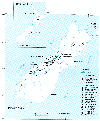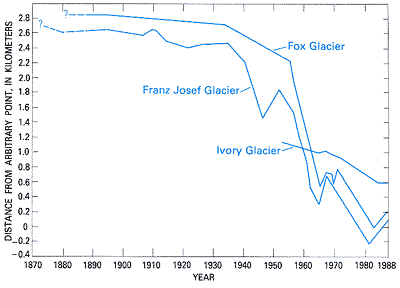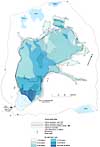Glaciers occur on the North Island on Mount Ruapehu and on the South Island along the crest of the Southern Alps from the Spenser Mountains in the north to southern Fiordland in the south. New Zealand has a humid maritime climate. The prevailing westerly winds bring 3,000 mm. of annual precipitation to the western coastal plains, 15,000 mm to just west of the main divide, and 1,000 mm to the eastern ranges. Easterly and southerly winds are important sources of snow east of the main divide. A comprehensive glacier inventory that has just been completed indicates that the total number of glaciers exceeding 0.01 km2 in area in the Southern Alps is about 3,155, with an estimated volume of 53.3 km3 and an area of 1,159 km2. There are six glaciers on Mount Ruapehu. The first published descriptions of New Zealand glaciers occurred in 1859. Early visitors made observations on positions of termini and rates of movement of the glaciers, and, in 1889, the first precise measurements were carried out. Modern studies began in the 1950's and included studies of flow, fluctuation, and mass and water balance on individual glaciers. The mapping of glaciers began with sketches of Franz Josef Glacier in 1865. The first maps were produced in the 1890's. Topographic mapping of the entire country at a scale of 1:63,360 with 100-ft contours was begun in 1958 and completed in the 1970's. Currently the Department of Survey and Land Information is preparing a new series at a scale of 1:50,000 with a 25-m contour interval. Aerial photographs of all glacierized areas are available; Landsat images cover all the areas, but not all the images are useful for glacial observations because of cloud cover or seasonally incorrect acquisition dates. Landsat images are more appropriate for studies of the larger glaciers, because the spatial resolution of the image is inadequate for glaciers smaller than about 1.0 km2 . However, Landsat imagery is useful in many cases in New Zealand for determining the rate and direction of glacier flow, changes in glacier snowline and margins, and past glacier extent on the basis of morainal sequences.
New Zealand comprises three main islands situated between 34° S. and 47° S. latitude. North Island has extensive areas of low mountain and hill country of Mesozoic and Tertiary sediments and a number of prominent volcanic cones. The mountains barely reach above the present vegetation limit, and the scant evidence available suggests that glaciers possibly did occur on the highest of these ranges during the Pleistocene. Three of the highest of the volcanic cones reach close to the permanent snowline, but only Mount Ruapehu, whose summit is at 2,752 m, supports snowfields, which form six glaciers.
South Island is more mountainous than North Island, and the boundary
between the Pacific and Indian plates cuts diagonally through the island from
southwest to northeast as the New Zealand Alpine fault. Toward the northeast,
the single fault splinters into a number of faults. Vertical and dextral strike-slip
movements continue and have rapidly uplifted the young, steep mountains east
of the fault line, with lesser uplift to the west and north of the fault line.
Rock types may be roughly divided into three simple categories: crystalline
plutonic rocks of Fiordland in the southwest; schist in the central south, which
wedges out northward adjacent to the fault; and sandstone to the east and north
of the schist.
Average
peak summits range from 1,850 m in Fiordland to 3,000 m in the central Southern
Alps (Mount Cook, the highest, reaches 3,764 m) and descend to 2,000 m in the
north-central Southern Alps. To the northeast young blocks of the Kaikoura Ranges
reach to over 2,700 m, but because they receive little precipitation these peaks
do not support glaciers (fig. 1).
Stewart Island presently supports no glaciers, although small glaciers were
present during the Pleistocene.
 |
Figure 1.-Location map showing glacial regions and locations of glaciers mentioned in the text. |
New Zealand has a humid maritime climate, with the Southern Alps lying across the path of the prevailing westerly winds. This situation creates steep, eastward precipitation gradients and a strong föhn effect. Mean annual precipitation rises rapidly from 3,000 mm along the narrow western coastal plains to a maximum of 15,000 mm or more in the western part of the Southern Alps a few kilometers west of the main divide. From this maximum, precipitation diminishes approximately exponentially to about 1,000 mm in the eastern ranges (Griffiths and MeSaveney, 1983; Chinn, 1979). Although westerly winds prevail, easterly and, more especially, southerly winds are important sources of snow to the east of the main divide. Precipitation is evenly distributed throughout the year.
Glaciers of the Southern Alps occur either in groups or singly from southern Fiordland in the south to the Spenser Mountains in the north (fig. 1). Several active rock glaciers occur on the inland Kaikoura Ranges. North of the Arthur's Pass area there are only a few small glaciers and permanent snow patches.
The glaciers
of the Southern Alps may be divided into four glacial regions containing groups
of the larger glaciers (fig. 1). To
the north, the Mount Whitcombe region includes the large Ramsay and Lyell Glaciers,
together with the ice plateau of the Bracken Snowfield, and extends south to
include the dual snowfields of the Garden of Eden and the Garden of Allah (fig.
2). The Mount Cook region contains the largest glaciers of the Southern
Alps. These include the Godley, Classen, Murchison, Tasman, Hooker, and Mueller
Glaciers east of the main divide, and the Franz Josef and Fox Glaciers (Sara,
1968) to the west. Farther south, the Mount Aspiring region has some extensive
névé-sheathed slopes surrounding Mount Aspiring and two main glaciers,
the Bonar and Volta. The Olivine Ice Plateau and adjacent valley glaciers south
of Mount Aspiring are included in this region. The Mount Tutoko region, the
southernmost region, encompasses the north Fiordland and central Fiordland glaciers.
Anderton
(1973) had previously identified 527 glaciers more than 0.1 km2 in
area and estimated the volume of water stored as perennial snow and ice in the
glaciers of the Southern Alps to be approximately 50 km3, with an
area of 810 km2. Results from the present glacier inventory indicate
that the total number of glaciers exceeding 0.01 km2 in area in the
Southern Alps is 3,155, with an estimated ice volume of 53.3 km3
and a total glacier area of 1,159 km2. In the Mount Whitcombe region
819 glaciers have been inventoried; 351 of these occur to the west of the main
divide (Westland area) and the remaining 468 to the east of the main divide
(Canterbury area). Many glaciers have areas close to 0.2 km2 , and
82 percent of the Canterbury glaciers are this size or smaller (fig.
3), while in Westland 70 percent of the glaciers are equal to or less than
0.2 km2 (fig. 4). Fifty percent
of Canterbury glaciers are smaller than 0.06 km2, while 50 percent
of Westland glaciers are smaller than 0.09 km2. Canterbury glaciers
predominantly face south to southeast, and most Westland glaciers face between
west and north (fig. 5).
Observation
of Glaciers
Historical Glacier
Observations
The first Europeans who might have seen the glaciers of the Southern Alps were the explorers Abel Tasman (in 1642) and Captain James Cook (in 1769), when they sailed along the West Coast of New Zealand, although neither of them mentioned seeing glaciers. The first published description of a New Zealand glacier appears to be of the Franz Josef Glacier, recorded in the log of the Mary Louisa when sailing off the West Coast in 1859, and subsequently published in the Lyttelton (New Zealand) Times, 6 July 1859 (Sara, 1970).
Descriptions of glaciers become abundant in the 1860's, soon after the discovery of gold stimulated extensive exploration and prospecting in alpine regions, especially on the West Coast. The earliest systematic records of glaciers appear in the journals and reports of C.E. "Mr. Explorer" Douglas and A.P. Harper. From the late 1860's onward Douglas explored and carefully reported on most of the notoriously impenetrable West Coast valleys (Pascoe, 1957). Later, mainly in the 1890's, A.P. Harper carried out a tremendous amount of exploration work for the Department of Lands and Survey, frequently in the company of Douglas (Harper, 1896 and 1946). Harper was also a mountaineer and explored many of the glaciers on the eastern side of the ranges. Further systematic records of the glaciers appear in the New Zealand Alpine Journal, first published in 1892.
Early volumes of the New Zealand Alpine Journal contain accounts of the visits of Julius von Haast to the headwaters and glaciers of Rakaia and Rangitata Rivers in 1861, and to Tasman, Hooker, and Mueller Glaciers in 1862. In 1865, von Haast made the first sketch of Franz Josef Glacier, and its terminus was first photographed in 1867 by T. Pringle (Sara, 1970). Throughout the 1860's to the 1880's the headwaters of the main rivers on the eastern side of the Alps were visited by explorers, while Douglas systematically explored each of the rugged forested valleys of the west to its headwaters glaciers. By 1900, guided tours were being conducted from both sides of the Alps on Franz Josef and Tasman Glaciers.
Many
of these early visitors made observations on the positions of the glacier termini
and on rates of ice movement (Mannering, 1891; FitzGerald, 1896). In 1889, T.N.
Brodrick began mapping topography and glaciers in the Mount Cook area
(Gellatly, 1985). Cross-glacier lines of stakes were installed on Tasman, Murchison,
and Hooker Glaciers, while painted stones were positioned in a line across Mueller
Glacier. This work was the first precise glaciological measurement carried out
in New Zealand. These sections were resurveyed in 1962 (Skinner, 1964). Observations
of the positions of the termini of Franz Josef and Fox Glaciers by surveys and
photographic records have been sporadically maintained since 1894 (fig. 6),
and occasional measurements of rates of movement have been made (Bell, 1910;
Speight, 1939). During the past two decades, National Park staff have taken
weekly photographs from fixed points, giving a permanent time-lapse record of
all fluctuations of glacier termini.
 |
Figure 6.-Measured variations in the position of the termini of the Fox, Franz Josef, and Ivory Glaciers. |
In 1957, I.C. McKellar of the New Zealand Geological Survey began measuring movement and ice stratigraphy on Tasman Glacier (Goldthwait and McKellar, 1962). In 1965, when this initial project was completed, the Ministry of Works initiated mass-balance measurements; this work continued until 1973 (Chinn, 1969). In 1972, ice thickness was measured over three sections across the trunk of the glacier (Anderton, 1975). Repetitive oblique photographs are being made from time to time by the Mount Cook National Park Board. A recent study has documented the retreat of the small, steep Stocking Glacier, situated between Mueller and Hooker Glaciers (Salinger and others, 1983). To the west, the fluctuations of Franz Josef and Fox Glaciers have been documented by Suggate (1950), Bowen (1960), Sara (1968, 1970), and Soons (1971), but flow measurements by Gunn (1964) and McSaveney and Gage (1968) are the most comprehensive of the studies made on the ice of these glaciers.
In
1968, T.J. Chinn of the Ministry of Works began mass- and waterbalance studies
on Ivory Glacier (fig. 7), a small
glacier west of the main divide chosen as part of an International Hydrological
Decade (I.H.D.) program of representative basin studies (Anderton and Chinn,
1978). These studies continued, along with energy-balance projects, until 1974.
In 1975, G. Bishop of the New Zealand Geological Survey, Dunedin, commenced
limited balance and movement studies on Dart Glacier in Otago; these studies
continue. On North Island, retreat of the glaciers of Mount Ruapehu was described
by Odell (1955) and Krenek (1959). Later, in 1960, permanent photographic stations
were installed (Heine, 1962), and balance studies were made on Whakapapanui
Glacier over 1968-69 (Thompson and Kells, 1973).
 |
Figure
7.-Glacier elevation-difference map of Ivory Glacier from April 1971
to March 1988. |
Glacier-snowline
elevations (the elevation of the end-of-summer snowline on a glacier) are being
measured in a program of annual photographic surveys of glaciers throughout
the Southern Alps. The first complete survey was made in 1978 (Chinn and Whitehouse,
1980). Mean snowline altitudes varied from 1,500 m in the south and west to
2,200 m in the east. The trend of the snowline surface shows strongly the influence
of westerly precipitation on the distribution of glaciers. Snowlines descend
perceptibly from the extreme west to a trough located parallel to, but somewhat
east of, the zone of maximum precipitation (Griffiths and McSaveney, 1983; Chinn,
1979). With decreasing precipitation, the snowline rises rapidly near the crest
of the main divide and continues to rise with a lower eastward gradient. Imposed
on this generalized pattern are complex topographic variations of two origins.
Large mountain masses, lying across the direction of the prevailing northwest
winds and west of the divide, generate precipitation-shadow areas, the result
being higher snowlines in the shadow area. This pattern of precipitation-shadow
areas is repeated east of the main divide. Where low passes occur, the precipitation-shadow
effect is drastically reduced; moist maritime air masses, therefore, can penetrate
east of the main divide, resulting in markedly lower snowlines than in the shadow
areas.
Gradients of the snowline elevation across the main divide vary from 25 m km-1 to 40 m-1 km. These gradients are up to four times as steep as those found at the glaciation limit2 (Porter, 1975) and 10 to 20 times as steep as those measured for arctic and subarctic regions (Andrews and Miller, 1972). Localized areas of very steep gradients occur that far exceed the mean values. The mean northeast to southwest gradient along the main divide is 1 m km-1 or 115 m per degree of latitude.
Present glacial studies include the Dart Glacier work by the New Zealand Geological Survey, and photographic surveys being conducted by the staff of the Westland and Mount Cook National Parks. In addition, the Water and Soil Division of the Ministry of Works and Development has a New Zealand Glacier Inventory program in progress under the United Nations Educational, Scientific, and Cultural Organization (UNESCO) World Glacier Inventory project.
2The lowest elevation
in a given locality at which glaciers can develop and be sustained.
| Home | Volume Contents | Glaciers of New Zealand (con't.) |
U.S. Geological Survey, U.S.Department
of the Interior
This page is https://pubs.usgs.gov/prof/p1386h/nzealand/nzealand.html
Contact: Richard S. Williams, Jr.,
and Jane G. Ferrigno
Last modified 05.07.00